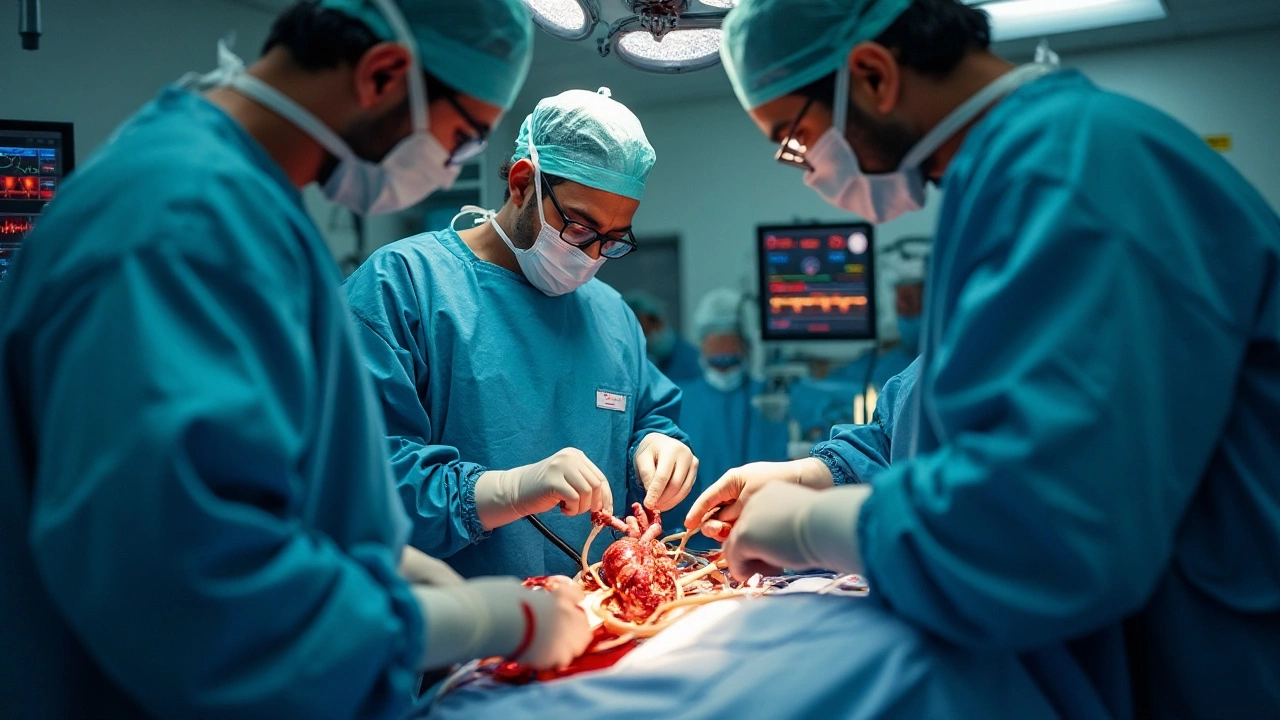Heart surgeries can be life-saving, yet they are not without danger. Some procedures stand out due to their complexity and the level of risk involved.
Diving into the world of cardiac surgeries, it's important to know which are considered the riskiest and why. Such knowledge not only helps demystify these medical marvels but also aids in making informed decisions should you or a loved one face the prospect of heart surgery.
In this article, we'll go deeper into three heart surgeries known for their high-risk levels. These procedures can be daunting, but understanding their challenges could prepare patients and families better.
- Understanding Heart Surgery Risks
- Coronary Artery Bypass Grafting
- Heart Transplantation Complexities
- Aortic Aneurysm Repair Dangers
- Tips for Preparing for Heart Surgery
Understanding Heart Surgery Risks
When it comes to heart surgery, the risks involved can often be as intimidating as the procedures themselves. The complexity of these surgeries is rooted in the very nature of the heart—our lifeline, tirelessly pumping blood throughout our bodies. Disrupting this essential process for surgical intervention requires precision and a deep understanding of human anatomy.
Heart surgeries range from minimally invasive procedures to extensive operations, each presenting its own set of challenges. For instance, Coronary Artery Bypass Grafting, a common surgery, requires rerouting blood around clogged arteries, which might sound straightforward but is exceedingly delicate. Even the slightest misjudgment can have significant consequences on the patient's health and recovery. Understanding the risks helps us appreciate the skill required and the care taken in each surgery.
A primary concern for any cardiac procedure is the recovery period. Post-surgery, patients are closely monitored in a specialized environment to preempt complications such as stroke or infection. A heart that's just been operated on is vulnerable, with its resilience varying from one patient to another based on factors like age, health condition, and lifestyle. Various statistics indicate that while the risk of complications exists, the success rate of heart surgeries has increased steadily over the years, thanks to advancements in medical technology and techniques. For instance, technological innovations in imaging and surgical methods have drastically reduced mortality rates even in high-risk operations. A balancing act of managing potential risks and reaping the life-saving benefits of heart surgeries is pivotal in the medical field.
Moreover, understanding the systemic risks involved extends beyond the surgical table. Anesthesia risk, the possibility of blood clots, and even the psychological toll on patients are part of the comprehensive assessment required. As Dr. James Forrester, a well-regarded cardiologist, once remarked,
"The heart, unlike any other organ, touches every aspect of our health. To operate on it isn’t just about addressing the physical ailment but also about considering the cascade of effects on the entire system."This perspective emphasizes the delicate equilibrium that surgeons must maintain.
Doctors today also advocate for patients to be well-informed about their procedures. Discussion about potential risks is a critical part of pre-surgery consultations. Understanding the nature of the surgery, what it entails, and the possible outcomes empowers patients, making the entire medical journey less daunting. By embracing new technologies and stringent safety protocols, the medical field continues to minimize the inherent risks and improve patient outcomes. Looking ahead, continuous innovation holds the promise of even safer cardiac procedures, allowing us to aspire to a future with fewer risks and better health.
Coronary Artery Bypass Grafting
Coronary Artery Bypass Grafting (CABG) is often discussed as one of the most essential yet risky surgeries within the realm of cardiac procedures. Its goal is to improve blood flow to the heart by bypassing the blocked arteries. Typically, this surgery is required when you have severe coronary heart disease, which is a result of plaque buildup in the coronary arteries. This blockage decreases blood flow and increases the risk of heart attacks, making CABG a critical intervention. The procedure involves taking a healthy blood vessel from another part of your body, often the leg or chest, and connecting it to the blocked coronary artery, creating a new path for blood flow.
The complexity of the CABG procedure demands a high level of expertise from the surgical team. The surgery typically takes 3 to 6 hours, and the patient is placed under general anesthesia. During the procedure, the patient's heart may be stopped using a heart-lung machine, necessitating precise execution to avoid complications. It's not unusual for the recovery period to extend over several weeks or even months, where patients must adhere to strict guidelines to ensure their health and safety. One study found that the mortality rate for CABG is between 1 to 3%, but this can vary depending on the patient's overall health, age, and lifestyle factors, adding a layer of concern for those facing the surgery.
Heart surgery, such as CABG, is not without potential added complications and risks. Patients may experience issues like infections, reactions to anesthesia, or even bleeding. The possibility of arrhythmias, which are abnormal heart rhythms, can arise due to the disturbances in the usual heart function. Furthermore, about 5% of patients might suffer a stroke during or after the surgery, underscoring the necessity for a thorough risk assessment before undergoing this procedure. Mental well-being can also be impacted, with a significant number of patients reporting increased levels of anxiety or depression post-surgery.
In terms of lifestyle adjustments post-surgery, CABG patients are often advised to adopt healthier habits to support their recovery and prevent future issues. This includes quitting smoking, reducing alcohol intake, maintaining a balanced diet rich in fruits and vegetables, and engaging in regular physical activity suitable for their condition. Regular follow-ups with healthcare providers are paramount to monitor heart health and manage potential complications. Such a comprehensive approach post-surgery contributes significantly to a successful long-term outcome.
"The essence of CABG transcends beyond the initial act of surgery, as proper patient adherence to post-operative care is critical in realizing the surgery's full benefits," Dr. Vivek Chaturvedi, renowned cardiologist and researcher, once said, highlighting the importance of holistic care.

Heart Transplantation Complexities
Heart transplantation is one of the most significant advancements in medical science. However, it remains a complex procedure with numerous challenges. This surgery involves replacing a failing heart with a healthy one from a deceased donor, a process that demands incredible precision and timing. One of the primary complexities lies in the matching process. The recipient's and donor's blood type, size, and body condition must be compatible, adding layers of logistical and scientific challenges to what is already a high-stakes surgery.
The surgery itself is no less demanding. Surgeons must carefully cut through the chest and remove the patient's heart, which is a delicate process that requires both expertise and steady hands. Any mistake can have fatal consequences, ensuring that only the most skilled surgeons usually undertake such operations. In addition, post-surgery care is crucial as it involves regular follow-ups and immunosuppressive medications, which help prevent the body from rejecting the heart surgery but also increase the risk of infections and other complications.
A heart transplant's success extends beyond the surgery room. The emotional and psychological adjustments required from the patient and their family can be overwhelming. Many patients struggle with the knowledge that their second chance at life is made possible by another person's death. Counseling and support groups are often recommended to help navigate these feelings.
According to Dr. Raghav Sharma, a renowned cardiac surgeon, 'A heart transplant is more than just a medical procedure; it's a lifetime commitment to adapting and managing one's health continuously.'
Success rates for heart transplants have improved over the years, thanks to advances in surgical techniques and post-operative care. Now, many patients go on to live long, fulfilling lives. However, the average lifespan of a transplanted heart is about 10 to 15 years, which means many patients may eventually require another transplant or alternative therapies. This underscores the importance of research and innovation in cardiology to enhance outcomes further. Table 1 below outlines some key statistics on heart transplantation outcomes worldwide over the past decade.
| Region | 5-Year Survival Rate | 10-Year Survival Rate |
|---|---|---|
| United States | 75% | 60% |
| Europe | 70% | 55% |
| Asia | 68% | 50% |
Heart transplants offer hope, providing a new lease on life for those who receive them. Yet, it is a journey fraught with trials, demanding resilience and a strong support system. Ultimately, understanding these complexities can help patients and their loved ones better navigate the challenges ahead.
Aortic Aneurysm Repair Dangers
The repair of an aortic aneurysm is one of the most challenging cardiac procedures, often demanding surgical precision and extensive expertise. When a section of the aorta, the body's largest artery, weakens and bulges, it can lead to a life-threatening condition if left untreated. Yet, the very procedure to correct this issue comes with significant dangers. The intricate nature of the surgery requires doctors to carefully balance the risk of rupture with the perils of intervention. During the operation, surgeons must delicately navigate around major blood vessels, with any misstep potentially leading to severe complications, including massive internal bleeding. The repair can be conducted through either open surgery or endovascular techniques, each with its own set of challenges and risk levels. Open surgery, while providing direct access to the aneurysm, involves large incisions and prolonged recovery times, posing additional risks, particularly for elderly or frail patients.
Endovascular repair, on the other hand, is less invasive but demands great care in deploying stent grafts within the artery. This minimally invasive technique is less taxing on the body, yet not without risk, including the possibility of endoleaks where blood continues to flow into the aneurysm. The chance of kidney damage from the dye used to highlight blood vessels is another concern during this type of repair. According to a report by the American Heart Association, approximately 10-15% of endovascular procedures may require subsequent intervention due to complications.
"While endovascular repair is a preferred option for many due to its minimally invasive nature, not every patient is suitable for this approach, highlighting the need for individualized treatment plans," notes Dr. James Franklin, a renowned cardiac surgeon.Choosing between open or endovascular repair demands a thorough consideration of the patient’s overall health, the aneurysm’s size and location, and potential genetic factors that might influence recovery. Understanding these complexities is essential not only for doctors but for patients as they navigate their treatment journey.
Preparing for Surgery
Proper preparation for aortic aneurysm repair can mitigate some of these risks, and involves a combination of patient education and medical evaluation. Patients undergoing this kind of surgery need to be assessed thoroughly to determine their suitability for either method of repair. This includes detailed imaging studies such as CT scans or MRIs to map the aneurysm and surrounding vascular structures. Such insights allow surgeons to plan the safest possible route to tackle the aneurysm, minimizing complications. Patients are also often advised to cease certain medications that could increase bleeding risk several days prior to the surgery. On the day of the procedure, maintaining stable blood pressure is vital, as fluctuations can exacerbate aneurysms. Postoperative care is equally crucial, with patients needing close monitoring for vital signs and early signs of complications. Regular follow-ups and imaging tests to examine the surgical site help ensure any issues are promptly addressed.
These medical marvels in heart surgery, though risky, have revolutionized life expectancy and quality for many living with aortic aneurysms. By understanding these dangers and preparing adequately, the odds of a successful outcome improve. For those facing this procedure, grasping the intricacies and working closely with their healthcare team is key to crossing the finish line with better heart health.

Tips for Preparing for Heart Surgery
Preparing for heart surgery can be a daunting experience fraught with emotional and physical challenges. Yet, there are several proactive steps that patients and families can take to alleviate some of the stress and ensure a smoother process. The first step often involves creating a comprehensive checklist of medical necessities and personal arrangements. Ensuring all medical records, previous test results, and any required pre-operative assessments are in order is imperative. These documents provide the surgical team with essential information about the patient's medical history, helping them tailor the procedure to individual needs. Moreover, having your affairs in order can be a source of immense relief, allowing you to focus solely on the surgery ahead.
Healthy living isn't just a mantra; in the context of pre-operative preparation, it’s foundational. Patients are generally advised to adopt healthier lifestyle practices at least a few weeks before the surgery. This could involve quitting smoking, adopting a balanced diet rich in fruits, vegetables, and lean proteins, and engaging in moderate physical activity as recommended by your doctor. A healthy body can immensely improve recovery times and outcomes, and it prepares your heart for the surgery’s rigors. It's amazing what a difference small changes can make when gearing up for a significant life event like heart surgery.
While physical preparations are essential, mental and emotional well-being should not be overlooked. Consider speaking with a counselor or joining a support group for individuals undergoing similar procedures. These resources can provide valuable perspectives and coping mechanisms to deal with fear or anxiety related to the surgery.
According to Dr. John Smith, a renowned cardiac surgeon, "Emotional preparedness is just as critical as physical health. The mind's power over the body’s healing process should never be underestimated." Involving close friends and family in your journey can also be emotionally fortifying, offering you a strong support network to lean on. Don’t hesitate to share your thoughts and concerns with loved ones.Another critical aspect is logistical preparation for the recovery period. It’s beneficial to arrange for post-surgery transportation and home care before the procedure. Set up a recovery area in your home where you can easily access everything you need without straining yourself. Making meal plans or organizing meal deliveries can ensure you maintain proper nutrition, which is crucial for healing. This preparation can minimize stress and allow you to focus on recovery once back home.
Understanding the possible risks and complications involved in heart surgeries can also make a significant difference. Discuss the surgical process thoroughly with your healthcare provider. Ask about any potential risks associated with the specific type of surgery you are undergoing and the steps that will be taken to mitigate them. This discussion should cover potential post-operative issues you may encounter. Heart surgery is not just a physical endeavor; enlightening oneself about the medical, logistical, and emotional aspects of the procedure ensures a holistic approach to preparation.
It’s also quite beneficial to engage in some form of relaxation techniques or stress-relief practices in the days leading up to the surgery. Techniques like meditation, deep breathing exercises, or yoga have been known to help calm the mind and soothe nerves. These practices not only promote mental peace but also contribute to stable blood pressure and heart rates, which are vital on the day of the surgery. Being relaxed can significantly impact the surgery’s outcome and set a positive tone for the recovery.

 What Happens If an American Goes to the Hospital in Europe?
What Happens If an American Goes to the Hospital in Europe?
 Herbal Supplements: What Are the 3 Main Supplements You Should Know?
Herbal Supplements: What Are the 3 Main Supplements You Should Know?
 Mental Illnesses: Understanding the Uncurable
Mental Illnesses: Understanding the Uncurable
 Why Is Therapy So Expensive? Unpacking the Real Costs
Why Is Therapy So Expensive? Unpacking the Real Costs
 Can Ashwagandha Cause Weight Gain? What You Really Need to Know
Can Ashwagandha Cause Weight Gain? What You Really Need to Know